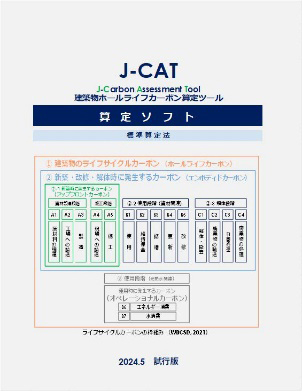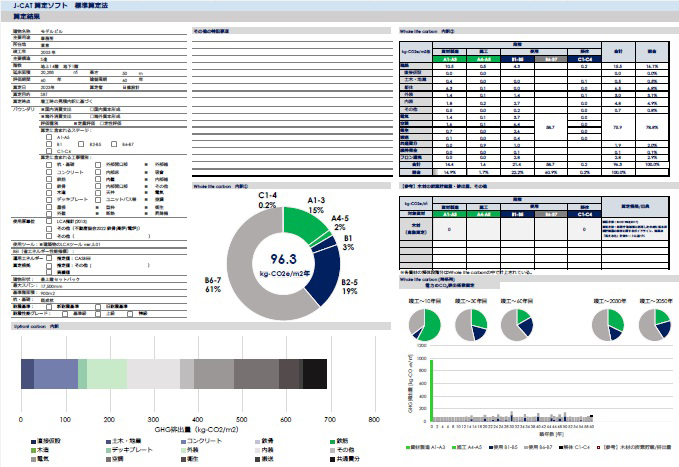J-CAT/Japan Carbon Assessment Tool for Building Lifecycle
About J-CAT

With the support of the Ministry of Land, Infrastructure, Transport and Tourism (MLIT), the Zero Carbon Building Promotion Committee was established in December 2022 with the Institute for Built Environment and Carbon Neutral for SDGs (IBECs) and the Japan Sustainable Building Consortium (JSBC) as joint secretariat. J-CAT is a tool (calculation software and manual) developed by the committee to calculate GHG (greenhouse gas) emissions, including CO2, through the entire building lifecycle.
Features of J-CAT
J-CAT has the following five features.
Feature1: Provides Three Calculation Methods According to the Purpose of Use
J-CAT offers three calculation methods to suit the purpose of use: the “Standard Calculation Method” for the most standard use from design to construction completion, the “Simplified Calculation Method” for rough estimation in the early design stage, and the “Detailed Calculation Method” for detailed calculation in the construction completion stage.
- Method 1: Simplified Calculation Method
- Method 2: Standard Calculation Method
- Method 3: Detailed Calculation Method
Feature2: Able to Calculate Whole Life Carbon.
J-CAT enables the calculation of whole life carbon through the entire lifecycle of a building in accordance with ISO21930 categorization, not only covering upfront stages from raw material procurement (A1) to construction (A5), but also extending to the in-use phase (B1-B7), demolition and removal (C1), and waste disposal (C4).

Whole life cycle stages (WBCSD 2021)
Feature3: Able to Calculate Based on Quantity as well as Monetary Value
In J-CAT, emissions intensity is primarily based on the "AIJ-LCA intensity database" by the Architectural Institute of Japan (AIJ), which is derived from the Input-Output Tables published by the Ministry of Internal Affairs and Communications. Although AIJ-LCA intensity data base uses material prices and/or contract quotes to calculate emissions, it is also possible to calculate emissions based on material quantities in J-CAT, which are not influenced by price increases or changes in contract amounts.
Feature4: Enhanced Library of Updated Default Values
In J-CAT, the method for calculating refrigerant leakage is in align with internationally approved calculation methods. Based on that, a combination of updated input values, which are quoted from the latest statistics and data samples, are available as default values. For example, the latest publicized leakage rate is used as well as refrigerant loss reduction measures made available in the calculation. Others include equipment replacement cycle and replacement rates quoted from the data samples of Building and Equipment Long-life Cycle Association (BELCA) and Building Maintenance & Management Center (BMMC).
Feature5: Enhanced Calculation Result Information
In J-CAT, detailed calculation results are provided to accommodate various applications, including breakdowns of whole life carbon and upfront carbon, results representation considering the timeline, and notation of carbon storage capacity. Additionally, based on the CASBEE evaluation result format consisting of building overview, appearance, evaluation results, and considerations, two types of result representations are available: one for the general users, and another for professionals. Users can utilize these formats according to their specific needs.

Image of J-CAT detailed calculation results
In addition to the above five features, J-CAT can accommodate a variety of greenhouse gas emission reduction methods, including reducing material quantities, adopting low-carbon materials, using wood, making construction efforts, prolonging the building life span, reducing fluorocarbons, and balancing operational and embodied emissions.
How to get J-CAT
Registration is required to use J-CAT. Please read the terms of use (only Japanese) carefully, register, and download J-CAT.

